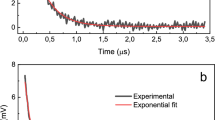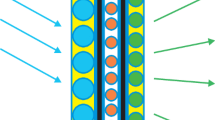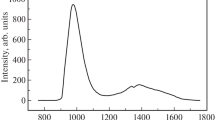The parameters of the interaction of 3d electron states with an electromagnetic wave, as well as the probabilities of magnetic and electric dipole transitions between states of the ground term of an iron ion, which is split by the crystal field, exchange interaction, and spin–orbit coupling, have been calculated. The dependences of the absorption lines on the magnitude and direction of the applied magnetic field have been determined. It has been shown that the optical diode effect discovered in [Sh. Yu, B. Gao, J. W. Kim, S.-W. Cheong, M. K. L. Man, J. Madeo, K. M. Dani, and D. Talbayev, Phys. Rev. Lett. 120, 037601 (2018)] can be explained by the interference of magnetic and electric dipole transitions.
Similar content being viewed by others
Avoid common mistakes on your manuscript.
1 INTRODUCTION
The authors of [1] discovered an interesting effect in the terahertz absorption spectrum of the Fe-ZnMo3O8 ferrimagnet: the intensity of light transmitted in one direction is more than two orders of magnitude higher than the intensity of light transmitted in the opposite direction. The authors assumed that this effect is due either to unknown toroidal moments or to dynamic magnetoelectric coupling. In this work, we report the microscopic calculation of energy levels, wavefunctions, and transition probabilities induced by the sum of interaction operators of electrons with the magnetic and electric components of an electromagnetic wave with different polarizations. The results indicate that the optical diode effect discovered in [1] is explained by the interference of magnetic and electric transitions between iron ion states of the ground configuration in octahedrally coordinated positions from oxygen ions. According to [2, 3], tetrahedral positions of Fe2+ ions in Fe-ZnMo3O8 are occupied primarily by nonmagnetic Zn ions. One can reach the same conclusion upon the comparison of reflection spectra for Fe2Mo3O8 and FeZnMo3O8 crystals presented in [4, Fig. 9]. The transition at an energy of 3500 cm–1 characteristic of the iron ion in a tetrahedral position is almost invisible in FeZnMo3O8.
2 SCHEME OF ENERGY LEVELS
The scheme of low-lying energy levels of the Fe2+ ion in octahedral positions was calculated within the standard crystal field theory [5] including the exchange (molecular) field induced by surrounding magnetic ions. The energy operator was written in the form
The parameters of the crystal field operator \(B_{q}^{{(k)}}\) were calculated from structural data [4] taking into account effects of the covalent bond with neighboring oxygen ions, as done for the Fe2+ ion in FeCr2O4 [6]. The calculation gives \(B_{0}^{{(4)}}\) = −9369 cm–1 and \(B_{3}^{{(4)}}\) = ‒9828 cm–1. The value \(B_{0}^{{(2)}} \simeq 550\) cm–1 is determined by the sum of almost identical contributions from charges of remote ligands and fields of the nearest environment but with opposite signs, which leads to a large error in its theoretical estimate. The parameter \(B_{0}^{{(2)}}\) was adjusted to reproduce the magnetic moment of 3.9μB/f.u. measured in [7] by Mössbauer spectroscopy. A value of \(\lambda = - 95{\kern 1pt} \) cm–1 was accepted for the spin–orbit coupling constant [5]. The last two terms in Eq. (1) include the external magnetic (H) and superexchange (molecular \({{B}_{{{\text{mol}}}}}\)) fields. The z quantization axis was chosen along the c crystallographic axis, and the x and y axes were chosen so that Im\(B_{3}^{{(4)}}\) = 0. According to experimental data [7], it was assumed that spins in a magnetically ordered state are directed along the c axis. The calculated transition frequencies are presented in Fig. 1.
(Color online) Magnetic field dependences of the calculated frequencies of absorption lines for the magnetic field orientations (orange lines) H || c with and (blue lines) H || a in comparison with experimental points from [1]. The intensities of the plotted lines are proportional to the probabilities of the corresponding transitions.
In the \({\text{|}}{{M}_{L}}{{M}_{S}}\rangle \) basis, the wavefunctions of low-lying energy levels in zero magnetic field have the form (argument is the energy in inverse centimeters)
Using information on exchange integrals obtained from the temperature dependences of the magnetic susceptibility in [2], the exchange field was preliminarily estimated as \({{B}_{{{\text{mol}}}}} \sim - 36.5{\kern 1pt} \) T. The parameters of the crystal field operator, as well as the exchange field magnitude, were then refined from the position of the 42 cm–1 terahertz absorption line in zero magnetic field and in a field of 12 T [1].
Our model differs from the single-center model with the effective spin \(S = 2\) proposed in [1], which is limitedly applicable because it disregards the exchange coupling between iron ions and orbital degrees of freedom. Experimental data shown by circles and triangles in Fig. 1 were obtained at T = 4 K, which is below the Curie temperature 12 K [7].
As seen in Fig. 1, our calculation correctly reproduces the tendency of variation of the \({{\psi }_{ \uparrow }} \to {{\psi }_{0}}\) transition frequencies with an increase in the magnetic field to 15 T. The calculated transition probabilities to the \({{\psi }_{ \downarrow }}\) states corresponding to the pale lines near 100 cm–1 are relatively low, but they increase with the magnetic field. For this reason, this state is observed in the experiment only in a field of about 16 T.
3 OPTICAL DIODE EFFECT AS A RESULT OF THE INTERFERENCE OF MAGNETIC AND ELECTRIC DIPOLE TRANSITIONS
The effective interaction operator of the 3d electron with the electric field generally has the form [8, 9]
where the braces stand for the direct product of the spherical components of the electric field vector and irreducible unit tensor operator; p = 1, 3, 5; k = 2, 4; and, since the position of the ion iron has trigonal symmetry, t = –3, 0, 3. The octahedral environment of Fe2+ consisting of oxygen ions is distorted and the center of inversion is absent [2]. Consequently, parity-fo-rbidden electric dipole transitions become allowed because of the admixture of excited configurations with the opposite parity. The parameters of the operator given by Eq. (3) were calculated on Hartree–Fock wavefunctions taking into account the mixing of states of the ground electron configuration \(3{{d}^{6}}\) with the excited configuration \(3{{d}^{5}}4p\) due to the odd crystal field in positions of Fe2+ and with states with charge transfer: when electrons from outer electron shells of oxygen ions transit to the 3d iron shell. The calculation yields the values (in debye):
The interaction operator with the magnetic field component of the electromagnetic wave was taken in the standard form
where n = 3.3 is the refractive index [1]. The coefficient of absorption is proportional to the square of the absolute value of the sum of the operators given by Eqs. (3) and (5):
According to Eq. (6), if both electric and magnetic dipole transitions are allowed simultaneously, the probability of the total transition includes terms proportional to the product of the magnetic and electric field; i.e., the dynamic magnetoelectric effect occurs. The intensity of light transmitted through the plate sample with the conservation of the polarization of the electric components varies also under the variation of the direction of the wave vector because the direction of the magnetic component of the field is reversed in this case. In terms of magneto-optics, this can be treated as the nonreciprocity effect caused by the interference between magnetic and electric dipole transitions. It is noteworthy that the interference of the mutually orthogonal electric and magnetic components of the same light wave occurs in this case. In contrast to the static magnetoelectric effect, the existence of an external static magnetic field is not necessary.
To verify our understanding of the origin of excitation spectra (it could be due to collective magnon-type excitations), we first calculated the relative transition intensities at different polarizations of the electromagnetic wave. The results of our calculation for transitions in zero field are shown in Fig. 2. As seen in Figs. 1 and 2, the proposed model reproduces the frequency and relative transition intensities within low-lying states of iron ions in low magnetic fields. Thus, we interpret absorption at a frequency of 42 cm–1 observed in [1] as a transition between the states \({{\psi }_{ \uparrow }}\) and \({{\psi }_{0}}\).
(Color online) Absorption spectra from [1] at T = 12–14 K. Vertical straight segments 1–3 indicate the calculated absorption intensities at the orientations of incident light components (1) \({{E}^{\omega }} \bot c\), \({{H}^{\omega }} \bot c\); (2) \({{E}^{\omega }}||c\), \({{H}^{\omega }} \bot c\); and (3) \({{E}^{\omega }} \bot c\), \({{H}^{\omega }}||c\). The bottoms of all three segments 1–3 coincide with each other, but only the part of segment 1 above segment 2 is seen and only the part of segment 2 above segment 3 is seen.
Figure 3 shows the calculated transition probabilities in the presence of a nonzero external magnetic field. The optical diode effect arises because matrix elements of the magnetic and electric dipole transition operators are approximately equal to each other. The interference effect is particularly pronounced on the \({{\psi }_{ \uparrow }} \to {{\psi }_{0}}\) transition. The green, red, and cyan lines in Fig. 3 are the absorption spectrum contours in magnetic fields of 0, +12, and –12 T, respectively, from [1]. The leftmost vertical line presents the absorption intensity in zero external magnetic field calculated by Eq. (6). According to Figs. 1 and 3, the calculated shift of the transition frequency with an increase in the magnetic field is smaller than the experimental value, but the tendency of increase in the optical diode effect corresponds to experiment. It is seen in Fig. 3 that the calculated absorption coefficients for the opposite directions of the external magnetic field with a magnitude of 12 T indeed differ by two orders of magnitude, as reported in [1].
(Color online) Absorption spectra from [1] at T = 4 K. Vertical straight segments indicate the absorption intensities at different directions of the applied magnetic field at the orientations of incident light components \({{E}^{\omega }}||c\) and \({{H}^{\omega }} \bot c\) calculated by Eq. (6) with a step of 2 T. The meaning of vertical straight segments is the same as in Fig. 2.
Figure 4 shows the magnetic field dependences of the calculated total absorption intensity divided by the value in zero magnetic field.
(Color online) Relative absorption intensity on the \({{\psi }_{ \uparrow }} \to {{\psi }_{0}}\) transition divided by the intensity in zero magnetic field at a constant direction of the wave vector \({\mathbf{k}}\) at orientations of incident light components (1) \({{E}^{\omega }}||c\), \(H||{{H}^{\omega }} \bot c\); (2) \({{E}^{\omega }}||c\), \(H \bot {{H}^{\omega }} \bot c\); and (3) \({{E}^{\omega }}||H \bot c\), \({{H}^{\omega }}||c\). The circles are relative absorption intensities estimated from the areas (integral intensities) under the absorption contours \(I = \int_\omega \alpha d\omega \) from [1].
According to our calculations, the optical diode effect should also be observed for the configurations \({{E}^{\omega }}||H \bot c\), \({{H}^{\omega }}||c\) and \({{E}^{\omega }}||c\), \(H \bot {{H}^{\omega }} \bot c\). This conclusion would be interesting to verify experimentally.
The deviation of the calculated curve from experimental points (circles) in the region of positive H values is probably due to the presence of a satellite of unknown origin in the high-field wing of the line.
4 CONCLUSIONS
The matrix elements of the magnetic and electric dipole transitions between the fine structure sublevels of the Fe2+ (5D) term in octahedral positions of the FeZnMo3O8 crystal have been calculated. It has been found that they are of the same order of magnitude; consequently, the interference of electric and magnetic dipole transitions responsible for the nonreciprocity phenomenon is possible. The field dependence and selection rules in the terahertz absorption spectrum have been successively reproduced within the developed microscopic model. The proposed theory of the optical diode effect can be used to predict this effect on various transitions in both terahertz and optical frequency ranges in various compounds with unfilled 3d shells.
Change history
12 January 2023
An Erratum to this paper has been published: https://doi.org/10.1134/S0021364022350016
REFERENCES
Sh. Yu, B. Gao, J. W. Kim, S.-W. Cheong, M. K. L. Man, J. Madeo, K. M. Dani, and D. Talbayev, Phys. Rev. Lett. 120, 037601 (2018).
D. Bertrand and H. Kerner-Czeskleba, J. Phys. Colloq. 36, 379 (1975).
S. V. Streltsov, D.-J. Huang, I. V. Solovyev, and D. I. Khomskii, JETP Lett. 109, 786 (2019).
S. Reschke, A. A. Tsirlin, N. Khan, L. Prodan, V. Tsurkan, I. Kézsmárki, and J. Deisenhofer, Phys. Rev. B 102, 094307 (2020).
A. Abragam and B. Bleaney, Electron Paramagnetic Resonance of Transition Ions (Oxford Univ. Press, Oxford, 2012).
K. V. Vasin and M. V. Eremin, J. Phys.: Condens. Matter 33, 225501 (2021).
F. Varret, H. Czeskleba, F. Hartmann-Boutron, and P. Imbert, J. Phys. 33, 549 (1972).
M. V. Eremin, JETP 129, 6 (2019).
M. V. Eremin, Phys. Rev. B 100, 140404(R) (2019).
ACKNOWLEDGMENTS
We are grateful to Dr. Joachim Deisenhofer for the di-scussion of features of terahertz spectroscopy of Fe1 ‒ xZnxMo3O8 crystals and stimulating remarks.
Funding
This work was supported by the Foundation for the Advancement of Theoretical Physics and Mathematics BASIS.
Author information
Authors and Affiliations
Corresponding author
Ethics declarations
The authors declare that they have no conflicts of interest.
Additional information
Translated by R. Tyapaev
The original online version of this article was revised: Due to a retrospective Open Access order.
Rights and permissions
Open Access. This article is licensed under a Creative Commons Attribution 4.0 International License, which permits use, sharing, adaptation, distribution and reproduction in any medium or format, as long as you give appropriate credit to the original author(s) and the source, provide a link to the Creative Commons license, and indicate if changes were made. The images or other third party material in this article are included in the article’s Creative Commons license, unless indicated otherwise in a credit line to the material. If material is not included in the article’s Creative Commons license and your intended use is not permitted by statutory regulation or exceeds the permitted use, you will need to obtain permission directly from the copyright holder. To view a copy of this license, visit http://creativecommons.org/licenses/by/4.0/.
About this article
Cite this article
Vasin, K.V., Eremin, M.V. & Nurmukhametov, A.R. On the Theory of Optical Diode on Iron Ions in FeZnMo3O8. Jetp Lett. 115, 380–383 (2022). https://doi.org/10.1134/S0021364022100307
Received:
Revised:
Accepted:
Published:
Issue Date:
DOI: https://doi.org/10.1134/S0021364022100307








